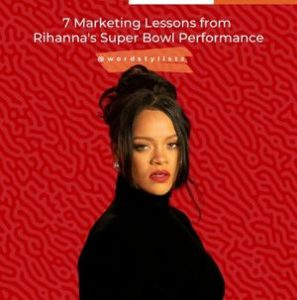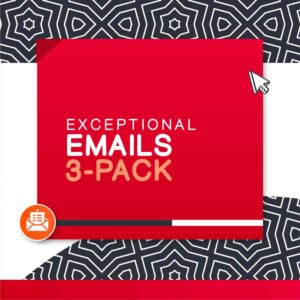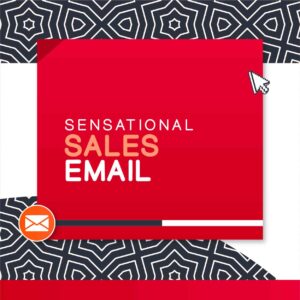
How to Find and Hire the Right Copywriter for Your Brand
Finding and hiring the right copywriter for your brand is an important decision that can have a significant impact on the success of your online
The Product Lounge is now closed. All final orders will be delivered within 10 business days. Please see Terms and Conditions for more details.

What is copywriting? While the definition may vary slightly depending on who you ask, our straightforward definition is this: Copywriting is the art of having a sales conversation in writing.
In short, copywriting is the act of developing written content for the purpose of advertising, marketing or promoting a product or service. The individuals who write copy, known as copywriters, can present the text, known as copy in many formats, including emails, social media posts, brochures, billboards, slogans, and more.
According to HubSpot the ultimate goal of copywriting is to persuade the reader, listener, or viewer to take a specific action – buy, download, attend, or simply engage with a piece of content. To achieve this goal, copywriters must craft compelling, personality-infused, and persuasive copy that resonates with the target audience.
The Content Marketing Institute notes that “neuro copywriting is the process of crafting a marketing text to appeal to human psychology, thus influencing engagement and motivation to learn more and purchase.” Translation: Copywriters must write in a way that appeals to the psychological way consumers make buying decisions.
Overall if you are lost on exactly what copywriting is and you still don’t know the difference between copywriting vs. content writing, then this ultimate guide is for you!
So, what is copywriting? To fully define it, we must also understand the target audience. Professional copywriters must employ a knack for writing in a voice that appeals to the target audience. To do this, copywriters must deeply understand the people they want to reach including their needs, struggles, fears, and desires. This understanding allows them to tailor their messaging and language to pierce the hearts of audience members and connect with them on a personal, human level.
Copywriting also involves creating a strong brand identity. While many believe a brand is comprised of merely visuals, a true brand encompasses a unique message, tone of voice, and personality. Copywriters play an integral role in developing this identity by creating compelling and consistent messaging that reflects the brand’s culture, values, and mission.
In addition to creating messaging, copywriters must also be skilled in crafting headlines and calls to action (CTAs). Headlines are the first thing readers see, and they play a massive role in grabbing their attention and drawing them into the content. CTAs, on the other hand, are the final push that encourages readers to hop off the fence and take action. A well-crafted CTA is often the deciding factor between a reader simply viewing and browsing the content and actually converting into a buyer.
Copywriting is also the cousin of search engine optimization (SEO). SEO is the process of optimizing web content to rank higher in search engine results pages (SERPs). This involves using keywords strategically throughout the content to alert search engines to what the content is about. Copywriters must be skilled in creating content that is both optimized for search engines and engaging for human readers.
Are you still asking, “what is copywriting?” Well, surprise, it’s not just about creating copy. It also involves the process of editing and refining that copy to ensure it is as effective as possible.
For example, at Word Stylistz, we employ copywriters and copy editors to write and review copy and refine the content flow before finalizing client orders for delivery. Our copywriters also work closely with designers, marketers and other stakeholders to ensure the content is not only persuasive but that it flows on the page in a way to enhance readability.
In short, copywriting is a vital component of any successful marketing strategy. It involves creating persuasive and compelling copy that connects with the target audience and influences the right people to take action.
Whether we’re developing an attention-grabbing headline, writing catchy product descriptions, or creating engaging website copy, copywriters help shape how consumers perceive and engage with a brand. With that said, copywriting is a challenging and rewarding career path for those who have an insatiable craving for executing effective advertising, marketing and communication methods.
There’s no way we can answer the question, “what is copywriting?” without exploring types of copywriting.
Successful marketing strategies must include copywriting. Copywriting aims to deliver engaging, persuasive copy relevant to the target audience. Copywriting covers many formats, from website copy to advertising slogans to product descriptions. Below, we’ll explore some of the most common copywriting niches.
Blog copywriting is a specialized form of writing that involves informing the reader and using the shared insight to influence action. While standard blog writing is typically informative and entertaining, a copywriter’s blogs are persuasive.
According to HubSpot, “blog writing is one of the most effective ways to increase organic search traffic and is a key element of a successful inbound marketing strategy.”
By creating high-quality, informative, engaging blog content, businesses can attract more website visitors, establish thought leadership in their industry, and ultimately generate more leads and sales.
Blog copywriting informs, entertains, and engages readers while also encouraging a conversion to generate revenue or more traffic by including a CTA. This CTA is crafted carefully to encourage the reader to do something specific, such as download an e-book, register for a training class or shop the online store.
Blog copywriting is an essential piece of SEO copywriting and content marketing, and it requires a deep understanding of the target audience, as well as a talent for persuasive writing that engages, educates, and entertains.
Digital marketing copywriting is all about developing digital text for promotional, marketing, informational, or advertising purposes. The goal of digital copy is typically to persuade, motivate, entertain, engage or inform a reader to heighten brand awareness, boost authority or influence, sell or market a product or service, influence a course of action, or convince an audience to take a specific step.
Although copywriting isn’t exclusive to online platforms, the explosion of consumers scouring the internet streets and consuming online content means many of today’s copywriters work in digital marketing. Digital marketing copywriting requires a deep understanding of digital communication tactics, as well as a talent for persuasive writing.
Brands rely on email copywriting to connect with and nurture email subscribers. With an average return on investment of $45 for every $1 spent, email copywriting remains one of the top ways to engage, entertain and educate audiences to boost brand awareness and sales. Sales emails should include an intriguing subject line, an engaging first sentence and a strong CTA.
Aside from promoting and marketing products and services, email copywriting is also a great way to inform audiences about the benefits and features of your products and services. Email copywriting requires a deep understanding of the target audience, as well as a talent for persuasive writing.
Sales page copywriting involves crafting a webpage with the sole purpose of connecting with potential buyers of a specific product or service and addressing everything they would want to know about the product or service. This includes removing any sales objections they may have and guiding them to make a purchase.
A well-written sales page that hits on all the critical selling points and persuasion elements has the potential to dramatically boost your conversions. Sales page copywriting requires a deep understanding of the target audience, as well as a talent for persuasive writing.
SEO copywriting is the process of pairing keyword-optimized content with persuasive content to appeal simultaneously to human browsers and search engine algorithms.
This type of copywriting creates a synergy between keyword research, SEO strategy, and foundational copywriting methods when crafting social media content, website copy, digital product descriptions, and other web content.
SEO copywriting requires a deep understanding of search engine algorithms, as well as a talent for persuasive writing.
Website copywriting is all about writing copy that prompts action when browsers hit conversion-driven websites. This type of copywriting is also called conversion copywriting because, when done right, it persuades website browsers to take specific steps and move deeper into the brand’s sales process.
Website copy is vital for converting web traffic into loyal buyers. Many businesses invest in quality website copywriting because it’s typically faster and more effective than attempting to craft conversion-boosting website copy themselves.
Website copywriting requires a deep understanding of the target audience, as well as a talent for persuasive writing. In addition, website copywriting often involves working closely with designers and developers to ensure that the copy fits seamlessly into the overall design of the website.
As you see, we can’t possibly address, “what is copywriting?” without uncovering at least some of the niches within the field. Now, this is NOT an exhaustive list. Copywriters also craft product and service descriptions, opt-in landing pages, social media and offline advertisements, video scripts, television commercials and more.
Whether it’s blog copywriting, digital marketing copywriting, email copywriting, sales page copywriting, SEO copywriting or website copywriting, each niche requires a unique set of skills, a writing pattern/framework, and a deep understanding of the target audience.
With the right skills and knowledge, a copywriter can position a brand to connect with its audience, build its authority and boost sales, revenue, and profits.
Copywriting is an essential ingredient in marketing, serving as the voice and tone of a brand and helping to resonate with and persuade potential customers. At its core, copywriting is the art of crafting persuasive, engaging, and memorable content that motivates people to take a specific step. And, as mentioned, copy can be distributed via webpages, social media posts, emails, sales pages, product and service descriptions, brochures, and more.
So, what is copywriting in marketing and how are the 2 interconnected? First off, copywriting is a valuable way to build brand awareness and recognition. By creating content that pierces the hearts and minds of your target audience and reflects your brand’s culture, values, and mission, you can establish a memorable brand identity and stamp your brand in the brains of potential customers.
In addition to building brand awareness, copywriting is also known for driving customer engagement and building trust. By creating content that speaks directly to your audience and addresses their needs, wants, challenges, fears, and desires, you can build a strong relationship with your customers and establish yourself as a trusted source in your industry.
One of the most vital roles that copywriting plays in marketing is boosting brand awareness and increasing sales. By creating persuasive and compelling content that highlights the benefits and unique features of your products or services, you can influence potential customers to hop off the fence and make a purchase or take some other desired action. Want to build a base of loyal customers? Great copy will help you do that.
Are you still wondering what is copywriting in marketing? In short, copywriting is essential for marketing as it crafts the message that ties your brand voice to the needs and desires of your audience. With the right approach and tactics, effective copywriting is a valuable, cost-effective way to skyrocket sales, success and profits in your business.
Now that we’ve addressed the question, “what is copywriting?” let’s explore how to become a copywriter. Becoming a copywriter is a popular career choice for those with solid writing skills and a passion for marketing.
For example, I became a copywriter after graduating with a journalism degree from The Ohio State University and discovering that I could earn a great living writing persuasive content – something I already loved to do.
Here are some steps on how to become a copywriter:
Want to improve your writing skills fast? Pick up a book and get to tapping on the keyboard. Write notes in your phone, ask colleagues and family and friends if you can write for them. When it comes to copywriting, practice undoubtedly makes perfect.
Understanding human psychology is vital for writing great copy. Now, this step isn’t about tricking or manipulating anyone to buy.
Instead, it focuses on leveraging human psychology to develop compelling sales messages tied to trends in buyer behavior.
Copywriting is a flavorful ingredient in the advertising and marketing mix. That means to do copy the right way, you’ll need to have at least some high-level understanding of advertising and marketing principles.
Need to brush up on advertising and marketing strategies? Read books and articles on marketing such as UnCloned Marketing.
A portfolio is the bread and butter of a copywriter’s career. You’ll use it to display your best writing samples that showcase your ability to craft various types of copy such as emails, product descriptions, website copy, and more.
To get the ball rolling with your portfolio, you can accept freelance writing projects, create content for personal writing projects or offer your writing services for free (in exchange for a glowing review) to local businesses or non-profit organizations.
Social proof is another important aspect of becoming a successful copywriter. Testimonials are powerful social proof that can help establish your credibility and attract new clients to your business. When you have a satisfied customer who is willing to provide you with a testimonial, be sure to showcase it prominently on your website, social media platforms and in your marketing materials. This will help build trust and credibility with potential customers who are considering working with you.
You can collect testimonials in many ways, such as through email surveys, online reviews, or social media comments. When asking for a testimonial, be sure to provide specific questions that will help your clients provide meaningful and detailed feedback easily. Some example questions might include:
What specific problem or challenge were you facing before you started working with me?
How did my copywriting help to address or solve this challenge?
What specific results did you see as a result of working with me?
How would you describe my service and process?
Would you recommend my copywriting services to others?
Social proof is a vital piece to building credibility and establishing yourself as a successful copywriter, so don’t skip this step. By showcasing positive feedback and social proof, you can attract new clients and grow your business over time.
Be sure to make collecting testimonials a regular part of your marketing efforts, and always be on the lookout for opportunities to share feedback from your happy customer.
Community is vital for any niche. Period. So, I urge you to come from behind the computer and attend industry events and conferences, join professional organizations, and connect with other copywriters and marketing professionals on social media.
Networking is priceless because it can help you learn about job opportunities, find potential clients, and build relationships with other professionals in your field.
You don’t need a degree or certification to thrive as a copywriter. (Read. That again.) However, having a degree in marketing, advertising or communications can provide you with advanced knowledge of the marketing and advertising principles you need to rise above the competition.
Alternatively, a certification in persuasive copywriting can help to validate your copywriting expertise.
Even if you have a degree in a related field, taking courses and workshops that specialize in teaching copywriting tactics can be helpful. For example, my course, Persuasive Copywriting is available in accredited colleges and universities worldwide.
Online courses and workshops are also available and can be a great way to learn new skills and advance your copywriting knowledge, so you never again ask, “what is copywriting?”
Applying for copywriting jobs and internships can involve searching online job boards, reaching out to local marketing agencies or businesses to inquire about career opportunities, using social media like LinkedIn, or applying for copywriting internships to kick-off your career in copywriting.
However you choose to apply for copywriting jobs or internships, let your portfolio and copywriting expertise speak for itself!
Copywriting is always changing, especially with the introduction of artificial intelligence (AI). Therefore, it’s important you stay informed about industry trends, new technologies and developments that can affect how you serve clients and the copywriting industry as a whole.
To do so, you’ll want to attend industry events, network with other copywriters, engage with industry organizations such as the American Marketing Association (AMA) and read industry-related publications.
Overall, becoming a copywriter requires a combination of strong writing skills, marketing knowledge, and a commitment to ongoing learning and development. By building a portfolio demonstrating your best work, networking with other professionals in the industry, and staying informed on industry trends, you can position yourself for long-term success as a copywriter.
Looking for your own copywriter? Learn the ins and outs of hiring a copywriter.
Mastering the art of persuasive copywriting requires studying copy used by brands across a variety of industries. Exploring copywriting examples from iconic brands is an excellent way for copywriters to step inside the brains of brilliant advertisers and learn persuasion tactics that work.
By analyzing the language, tone, and messaging iconic brands use, you’ll pull back the curtain and learn pro tactics for creating content that speaks directly to a specific target audience.
Ready to up your copywriting expertise? Check out these copywriting examples from notable brands we all know and love:
Savage X Fenty, a lingerie and loungewear brand developed by singer, actress, and mogul Rihanna, leverages copywriting to empower women of all shapes and sizes and deliver a message of body confidence and inclusivity.
Savage X Fenty’s approach to copywriting showcases how relatable brand messages can develop deep connections with audience members. Through its empowering and relatable content, Savage X Fenty has created a squad of loyal customers and fans.
Read More about Rihanna’s Marketing strategy and 7 tips to take away from her 2023 Superbowl Half Time Performance
You’d have to be living under a rock for decades to not have heard the iconic tagline, “Just Do It.” First launched in 1988, the slogan was created to inspire athletes to push toward their goals, even against all odds.
Today, these tiny 3 words are synonymous with Nike’s brand and have been used in countless advertising campaigns and marketing materials over the years.
Apple’s “Think Different” campaign champions the creative spirit of Apple’s customers and solidifies the brand’s standing as a leader in innovative technology.
Since 1997, the slogan has been featured in print ads and television commercials highlighting famous creative thinkers such as Albert Einstein, Pablo Picasso and Martin Luther King Jr.
Coca-Cola’s “Share a Coke” campaign hit the advertising scene in 2011 as an innovative way to use copywriting to establish personal connections with consumers.
Adding names to Coke bottles and cans was a big hit – pulling in a 2.5% increase in sales and 500K social media posts.
Our late, great client’s cosmetics company, AJ Crimson Beauty, is a fantastic illustration of how to use persuasive copywriting to establish a brand and engage a target audience.
The brand’s messaging emphasizes inclusivity and self-expression with catchphrases like “Beauty for everyone” and “Inclusive. Innovative. Imperative.”
The company’s strategy for copywriting showcases how to incorporate persuasive messaging to create a recognizable and enduring brand identity. The underlying ideals of inclusivity and self-expression, as well as AJ Crimson Beauty’s emphasis on fun and flirtatious product descriptions, and language that is approachable and powerful, have solidified its place as a pioneer in the beauty sector.
Remember these hilarious commercials and print ads from Old Spice? Featuring actor Isaiah Mustafa and his witty monologue, this campaign used comedic copy to revitalize the brand and massively increase sales.
In 2014, Airbnb launched its “Belong Anywhere” campaign and demonstrated to the world how to use copywriting to build a personal connection with consumers.
“Belong Anywhere” is a simple, yet meaningful statement that empowered travelers to believe they could truly feel like they belong anywhere they travel to. These 2 words helped Airbnb put its mark on the hospitality industry and pulled in a significant increase in bookings.
If a benefits and features statement all packaged with a nice bow was a slogan, it’d be this one from the popular M&M’s brand. I mean, who wants chocolate all over their hands while trying to enjoy an on-the-go snack? NOBODY.
M&M’s capitalized on this lovable feature and demonstrated how the right words can be used to highlight the core features and benefits of a product.
You really can’t go wrong with a name like FUBU, which stands for “For Us, By Us.” Emerging as an iconic brand in the 1990s, FUBU is a glowing example of how to use copywriting to build a relatable brand that empowers and celebrates Black culture.
FUBU’s copywriting focused on language unique to the hip-hop culture to forge an undeniable bond between the brand and young people in urban communities. The brand’s success was greatly influenced by its messaging and branding which created a strong sense of relatability amongst its fans and buyers. It’s through this messaging that FUBU was able to establish itself as a leader in the fashion industry and open the door for other brands to use language that honors their culture and beliefs.
The popularity of FUBU is a fantastic illustration of how powerful copywriting can be when used to develop a brand and engage a target audience. You can build a devoted consumer base and experience long-term success by adopting language and messaging that appeals to a specific community and by developing a strong and memorable brand identity.
While some of us first heard of the brand in that social-media-shattering moment when Beyoncé put us all up on game about this Black-owned purse designer, Telfar has been on the scene since 2005. Launched as a clothing line with gender-neutral apparel and accessories and an inclusive approach to fashion, the brand’s copywriting proves how good messaging can contribute to the creation of a distinctive brand identity.
The clarity and simplicity of Telfar’s copywriting are noteworthy. With words like “Not for you — for everyone” and “It’s not for you — it’s for everyone,” the company showcases its commitment to embracing diverse audiences and championing inclusiveness.
The way Telfar approaches copywriting is an excellent illustration of how powerful and memorable brand identities can be created through the use of effective messaging. Telfar has been successful in building a devoted following and establishing itself as a leader in the fashion business by concentrating on inclusivity and diversity and by employing straightforward, understandable and accessible copy.
Did you know the “Got Milk?” campaign is recognized as one of the greatest of all-time advertising campaigns aka the GOAT? Who knew that milk mustache would become so famous?!
Celebrities from every corner of Hollywood rocked a milk mustache and showcased the iconic slogan, “Got Milk?” to demonstrate the nutritional value and benefits of drinking milk.
The most notable rebirth of the iconic campaign surfaced in 2015 when it teamed up with tennis superstar Serena Williams to launch “Milk Life.” This campaign was designed to intrigue a new generation of health-conscious consumers by showcasing athletes as living proof that “milk does a body good.”
Boasting a sizable increase in milk sales and awareness of the nutritional benefits of the beverage, the campaign stands as one of the best examples of how a classic campaign can be rebirthed to a new generation of consumers.
Learn more about ad copywriting in our post How to Write Advertising Copy
Now that you’ve received the answer to your burning question, “what is copywriting?” we urge you not to waste another minute struggling to create compelling, effective copy for your brand. Trust the experts at our top-rated copywriting services business to elevate your brand with an enticing, cash-generating copy.
With years of experience and a proven track record of success, our pro copywriters know exactly how to craft messaging that resonates with your target audience and drives real results.
From landing pages to email campaigns, we have the expertise and creativity to amplify your brand’s voice. Invest in the power of great writing today and see the difference a top-notch copywriting services business can make for your brand.

Finding and hiring the right copywriter for your brand is an important decision that can have a significant impact on the success of your online

The Rihanna marketing strategy and her overall Savage-Fenty campaign are two prime examples of how to create an attention-grabbing content and stamp your brand in

What’s the difference between a sales page vs. landing page? In short, landing pages are used to gather contact information, while sales pages are used

Valentine’s Day is a time to celebrate love and affection, and what better way to show love to our business and clients than by collecting



